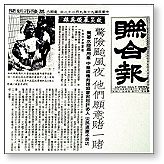|
Media
Reports
|
|---|
Heroes Behind the Rescue Work
Risk Their Lives on a Typhoon NightMembers of the Chinese Amphibious Rescue Society save many lives with their amphibious vehicle, but claim no credit despite gratitude from victims.
Keelung, Formosa
Saturday, September 22, 2001
(Originally in Chinese)Despite flooding in the first two stories, the Sanatorium run by Lin Han-chang (left), principal instructor of the Chinese Amphibious Rescue Society, offered shelter to over fifty victims on the higher stories. (Photo by reporter Li Hui-hsuan) [Reporter Li Hui-hsuan] "On the night of Typhoon Nari, our family of five was trapped near the Wutu freeway interchange. We waited for more than an hour before we finally saw a fireboat that saved our whole family." This is an account given by Yu Chien-chu of Hsi Tou Street. Lin Yu-ming of Tu Nan Street and six other family members were also saved just in time by a "waterborne fire engine," as they called it. This rescue vessel, described in many ways by different people, was actually an amphibious vehicle designed and manufactured by citizen Tseng An-ping. The victims of the Typhoon were saved in a rescue effort by the Chinese Amphibious Rescue Society.
During the six hours of heaviest flooding, the Rescue Society saved over eighty trapped victims from the Baifu Community and Tu Nan Street, and settled some of them in the Hsi-an Sanatorium on Tu Nan Street, run by their principal instructor Lin Han-chang. Their heroic story spread rapidly in the affected area, and many victims were anxious to thank them. However, the rescuers claimed no credit for their efforts.
Recalling the situation on that eventful night, a member of the rescue team thus described the "terrifying waves in a stormy sea": Even then, they were willing to stake their lives and take the risk. A team member narrated what he saw as follows: "A mother and her daughter stood on elevated ground; one of them was pregnant. We quickly pulled them into the vehicle and sent them to the Miners' Hospital as soon as possible. Following the beam of our spotlight, we saw a white helmet, a sign that someone might be trapped. We looked around and saw a tall man immersed in water up to his chin and clinging to the eaves of a house. Staying close to him was a black dog, standing on a piece of floating timber. When our amphibious vehicle drove toward them, radiant joy appeared in their previously desperate eyes.
Another team member recalled hearing someone yell, "Hey! There is someone here!" But the voice sounded like that of a wailing ghost. Some victims sent out very dim torchlights in the hope of getting help. In a makeshift sheet--metal house, the water was only one foot from the ceiling, and there were five persons trapped inside. The rescue team members first secured themselves with ropes, then dove through the water into the house, and persuaded the victims to hold their breath and dive into the water with their eyes closed. That was how they were saved. A pregnant woman carrying a child on her back was trapped on the second floor of a house, and was about to be immersed in the flood water. Four or five rescue team members lined up as though they climbed a wall to save the pregnant woman and her child. Other victims looking on were horrified to see their dangerous action. When the rescuers finally succeeded, a loud round of encouraging applause broke out from the onlookers.
Members of the Rescue Society are fellow practitioners who follow Supreme Master Ching Hai. They raise their own funds and are fully equipped with rescue equipment. They have developed and trained themselves in a unique rescue method. Yet, when they appear at scenes of disasters, their performances prove that they are first class professional rescuers.
|
Media Reports |
|
| * | New York Newsday |
| * | The Oakland Tribune |
| * | |
|
News
No. 127 |
|
